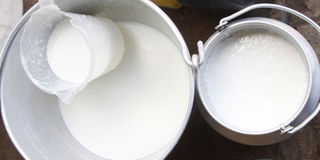How to prevent and treat milk fever

Unprocessed milk. One out of 20 cows die from milk fever, and 80 per cent of the cases occur a day before or after calving. FILE PHOTO / MARTIN MUKANGU
What you need to know:
- Milk fever is caused by low calcium levels in an animal’s bloodstream.
- In advanced cases, the cow lies on its side, seemingly dead and can’t get up, with muscle tremors in the head and limbs.
One out of 20 cows die from milk fever, and 80 per cent of the cases occur a day before or after calving. Acting quickly will save a farmer from losing the animal.
Milk fever is a metabolic disease commonly known among dairy farmers as the "falling disease." It is caused by low calcium levels in an animal’s bloodstream.
Normally, the cow suffers from the disease just before or after calving, when demand for calcium for milk production exceeds the body’s ability to mobilise calcium reserves.
It is important to know the signs of milk fever to save your animal from dying. The disease causes reduction in milk yields by up to three times during the lifespan of the cow if preventive measures are not taken promptly.
Incidences of the disease occur more commonly in older cows, with cattle breeds such as Jerseys being more susceptible in dairy than beef-cattle breeds.
THE SYMPTOMS
In a mild case of milk fever, the animal always seems quite normal, but experiences difficulties in standing. If the cow succeeds in rising, she staggers but soon falls.
In advanced cases, the cow lies on its side, seemingly dead and can’t get up, with muscle tremors in the head and limbs. At times the tongue sticks out and the body seems bloated.
What can farmers do to treat and avoid cases of milk fever?
Feeding rations high in calcium before and after calving exposes a cow to greater risk of milk fever, with high-producing animals being at the greatest risk.
Treatment has to be carried out immediately and injection with an intravenous solution of 40 per cent calcium borogluconate will lead to the cow standing up within 15 to 20 minutes after the injection.
DIETARY MANAGEMENT
However, in advanced cases, the cow may take up to two hours to be back on its feet.
Proper dietary management will prevent most cases of milk fever. Feeding the cow on high fibre – low calcium diet will keep the disease out of bay.
It is advisable and recommended that farmers pay close attention to mineral and fibre levels in the animal’s diet prior to calving. One further needs to feed the cows plenty of hay one to two weeks before calving.
It is also important to improve a cow’s comfort to eliminate problems that may interfere with appetite thus trigger milk fever. Lastly, it is important to consult a veterinary doctor to overcome the problem if it persists.
The writer is an animal nutritionist, Department of Animal Science, at Egerton University. [email protected]




